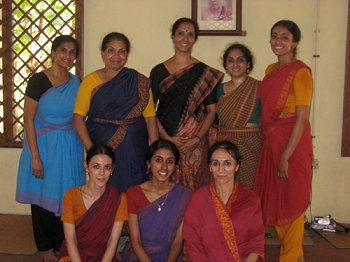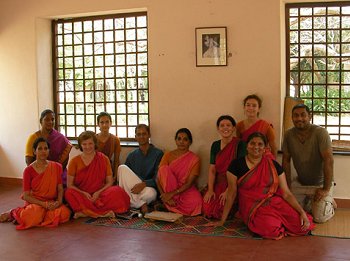
|   |

|   |
Magical moments in dance: My experiences at Kalakshetra Winter Camp 2011 - Ragothaman Yennamalli e-mail: ragothaman@gmail.com February 26, 2011 "Vidyathuraanaam na sukham na nidhra" One, who wants to acquire knowledge, should not think of physical comforts; should be prepared to forgo even sleep. This quote aptly summarizes my experience at Kalakshetra's first winter dance camp from 3rd through 12th January 2011. I felt elated at my selection for the camp and eagerly awaited to learn from the masters at Kalakshetra. We warmed up on the first day with introductions and an overview by Leela Samson (the Director of Kalakshetra) on what was in store for us over the next 10 days of the camp. I feel that some "magic" prevails not only in the environs of Kalakshetra, but also in the people. Each day began at 6am with a Yoga session conducted by Jyotsna Buch either in front of the lotus pond at the Art Department or at the newly built ‘Padma Pushkarni.' As the session progressed, we could see the lotuses blossom akin to the opening of each Chakra in the body. Our chants would add to the transcendental effect and I could feel the magic of Kalakshetra pervading through us. Even after the physically demanding dance sessions throughout the day, I was more than happy to wake up early the next morning just to feel these magical moments.   We had two-hour long dance sessions in the morning and in the evening conducted by gurus Nandini Nagaraj, Nirmala Nagaraj and Shaly Vijayan. Each of these classes were enriching and exciting. A dancer learns, understands and adopts a new composition in a unique way, and we were blessed to have such good teachers who not only hastened this process but enhanced it by highlighting the aesthetic nuances of each composition. A dance camp is naturally incomplete without abhinaya sessions. In this camp, we were fortunate to learn abhinaya from Bragha Bessel. Her method of teaching made the daunting task of navigating the ocean of abhinaya easier and enjoyable. I realized the importance of her advice that developing abhinaya for a dancer is similar to planting a sapling and watch it grow into a big tree! Every day we had two lecture sessions on different aspects of Bharatanatyam. I could comprehend the emphasis of such a holistic way of learning since these lectures made us understand the dynamics of the dance form better. We had lectures by Dr. N. Ramanathan on music appreciation, Dr. Raghuraman on Tamil compositions, Dr. Pappu Venugopala Rao on Telugu compositions, Hari Padman on Teermanam, Prof. Seetharama Sharma on Nattuvangam, Dr. Chithra Madhavan on the sculptures and architectural beauty of Mamallapuram and Jayachandran on temple rituals. Dr. Ramanathan's classes were enthralling as he talked about the nuances of Carnatic music in dance and the presence of different layers in the music. For example, the dancer's footwork, the mridangam patterns, and the nattuvangam can be viewed as different layers that make up a Varnam and juxtaposition of these layers make an interesting study. Dr. Raghuraman's explanation on the origins and evolution of Tamil Padams was interesting. He also highlighted the anthologies in Sangam literature, in which the nayaka is the central character. To fully appreciate and understand the undertones of any poetry, it is important to be well-versed in the language. As I don't speak or understand Telugu, I found Dr. Pappu Venugopala Rao's detailed explanation of the lyrics in Telugu Padams and Javalis an eye-opener. He explained the importance of selecting an appropriate Padam for a performance and gave us pointers to identify the nayika bheda within a Padam. Prof. Seetharama Sharma skillfully demonstrated different but subtle nuances in the patterns weaved for the same korvai on the nattuvangam.   Dr. Chithra Madhavan explained various sculptural and aesthetic aspects of Mamallapuram and dispelled some of the myths associated with the place, such as the ‘Pancha Pandava Rathas' are not associated after the Pandavas and they are not chariots as well. As a follow up on these lectures, we went on a tour to Mamallapuram and she guided us through the monuments that she had described in her lectures. Her insightful descriptions of the sculptures enabled us to fully appreciate the rich treasures that anonymous Pallava sculptors had left behind as legacy. Jayachandran's lectures on the origins of temple rituals and festivals, and the role of Devadasis provided a fresh perspective on temple rituals that are routine for us as Indians. I understood how each and every event in a temple intricately connects the spiritual to the mundane. Hari Padman's class on Teermanams was instrumental in strengthening our basics. The camp concluded with an insightful session with Leela Samson. She emphasized the importance of balance and harmony in a dance, in a dancer and in the art created through dance. I feel these are the simple facts that are instrumental in transforming a performance into a masterpiece. On the last day of the camp, we walked around the Theosophical Society and visited the bronze gallery at Egmore museum. It was inspiring to visit the stage where Rukmini Devi had her arangetram at the Theosophical Society in 1935, which led to the formation of Kalakshetra. The day ended with Guru Kalanidhi Narayanan distributing certificates to all the participants and I felt blessed to receive my certificate from her. Kalakshetra also had a surprise in store for us – we were treated to a special performance by three Kalakshetrians! The organizers and volunteers at the camp made our stay at Kalakshetra comfortable and I wouldn't be exaggerating if I add that we were thoroughly pampered! On the whole, it was an enriching experience to meet, learn and interact with people sharing my passion for dance and I am eagerly looking forward to attend the next year's camp. Ragothaman Yennamalli is a student of Bharatanatyam learning from Guru Vijayalakshmi Ramanan, New Delhi. He thanks Anupama Bhat for her motivation. |